国立科学博物館 | |
 National Museum of Nature and Science,Tokyo | |
| Established | 1871 [1] |
|---|---|
| Location | Ueno park, ueno, Tokyo |
| Coordinates | 35°42′57″N 139°46′35″E / 35.715939°N 139.776527°E |
| Visitors | 2,884,518 (2017) [2] |
| Website | www |
The National Museum of Nature and Science (国立科学博物館, Kokuritsu Kagaku Hakubutsukan) is in the northeast corner of Ueno Park in Tokyo. The museum has exhibitions on pre-Meiji science in Japan. It is the venue of the taxidermied bodies of the legendary dogs Hachikō and Taro and Jiro. A life-size blue whale model and a steam locomotive are also on display outside.
History
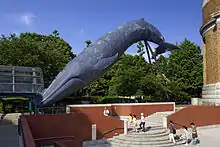

Opened in 1871, it has had several names, including Ministry of Education Museum, Tokyo Museum, Tokyo Science Museum, the National Science Museum of Japan, and the National Museum of Nature and Science as of 2007.[3] It was renovated in the 1990s and 2000s, and offers a wide variety of natural history exhibitions and interactive scientific experiences.
It was completed as the main building of the Tokyo Science Museum in September 1931 as part of the reconstruction project after the Great Kanto Earthquake. Neo-Renaissance style. Designed by Kenzo Akitani, an engineer of the Ministry of Education, Culture, Sports, Science and Technology, Building Division. The building is the most visited museum in Japan, and looks like an airplane when viewed from above. In addition to the exhibition hall, it has facilities such as a dome for astronomical observation and an auditorium.[4]
It is designed to withstand earthquakes of the Great Kanto Earthquake class, and it is said that there is no problem in light of the current Building Standards Act standards.[5]
In 2021, the museum organized the Pokémon Fossil Museum, a travelling exhibition based on the Pokémon franchise, in collaboration with The Pokémon Company. The exhibition opened at the Mikasa City Museum in Mikasa, Hokkaido, Japan, on 4 July 2021, and remained there until 20 September.[6][7] It has since been hosted by several other museums across Japan, including the National Museum of Nature and Science, which hosted it from 15 March to 19 June 2022.[6] A virtual tour of the exhibit as it appeared in the museum was also made available online.[7][8][9]
Exhibition buildings
Nihonkan (Japan Gallery)
The theme of the Ueno Main Building is "Aiming for the coexistence of humankind and nature," and consists of two exhibition halls, the Japan Pavilion and the Earth Pavilion.[10]


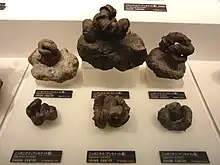
 Meteorites fell in Japan
Meteorites fell in Japan Japanese crested ibis (Nipponia nippon)
Japanese crested ibis (Nipponia nippon)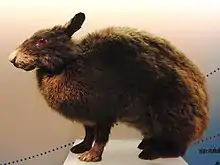
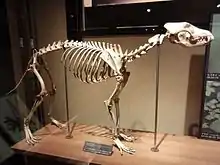 Honshu wolf (Japanese wolf)
Honshu wolf (Japanese wolf)
 Papier-mache terrestrial globe, created by Shibukawa Shunkai in 1695. Important Cultural Properties of Japan
Papier-mache terrestrial globe, created by Shibukawa Shunkai in 1695. Important Cultural Properties of Japan

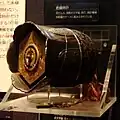 Tsurigane-dokei (hanging bell-shaped clock)
Tsurigane-dokei (hanging bell-shaped clock)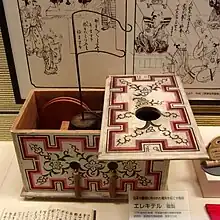 The Elekiter (replica) made by Hiraga Gennai
The Elekiter (replica) made by Hiraga Gennai Paleoparadoxia Skeleton
Paleoparadoxia Skeleton
Chikyūkan (Global Gallery)
The theme is "History of Earth Life and Mankind". The exhibition area is 3 floors above ground and 3 floors below ground.[11] The first phase of construction was completed in 1998. The permanent exhibition will be open to the public from April 24, the following year. Grand opening on November 2, 2004 after the completion of the second phase of construction. The renovation work of the north exhibition hall started in September 2014, and the construction was completed the following year, and the grand opening was held on July 14.
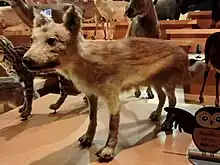 Honshu wolf (Japanese wolf)
Honshu wolf (Japanese wolf) Giant pandas named "Fei Fei" (left) and "Tong Tong" (right)
Giant pandas named "Fei Fei" (left) and "Tong Tong" (right) Myriad year clock, 19th century. Important Cultural Properties of Japan
Myriad year clock, 19th century. Important Cultural Properties of Japan

 Hayabusa model
Hayabusa model Mitsubishi A6M Zero (Zero Fighter) Model 21
Mitsubishi A6M Zero (Zero Fighter) Model 21 Zero Fighter Plane Model
Zero Fighter Plane Model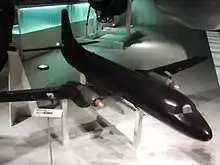 NAMC YS-11 wind tunnel model
NAMC YS-11 wind tunnel model
 Skeleton of sperm whale
Skeleton of sperm whale Animal collection
Animal collection Specimen of giant squid
Specimen of giant squid
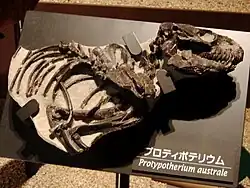
 Fossil of Triceratops named "Raymond"
Fossil of Triceratops named "Raymond" largest taxidermy of Mola mola
largest taxidermy of Mola mola
 The largest fragment of Nantan meteorite
The largest fragment of Nantan meteorite

 Taxidermy Displays
Taxidermy Displays
National research facility
Museum research facility
Other National research facilities
Access
 JU JK JY JJ G H Ueno Station
JU JK JY JJ G H Ueno Station- JK JY Uguisudani Station
- KS Keisei Ueno Station
See also
References
- ↑ "東京国立博物館の歩み". 東京国立博物館. p. 20. Retrieved 2019-02-27.
- ↑ "概要2018" (PDF). 国立科学博物館. p. 20. Retrieved 2019-02-27.
- ↑ Profile of the National Museum of Nature and Science 2007, page 23
- ↑ 文化庁 プレス発表資料「国宝・重要文化財(建造物)の新指定について」 平成20年4月18日
- ↑ "旧東京科学博物館本館". 文化庁. Retrieved 2019-02-27.
- 1 2 "巡回展「ポケモン化石博物館」Pokémon Fossil Museum". Kahaku.go.jp. National Museum of Nature and Science. Archived from the original on 20 October 2022. Retrieved 20 October 2022.
- 1 2 Kuhnke, Oisin (14 July 2022). "You Can Now Visit Japan's Pokemon Fossil Museum Virtually". GameSpot. Retrieved 20 October 2022.
- ↑ Dinsdale, Ryan (13 July 2022). "Pokémon Fossil Museum Virtual Tour Lets You See the Japanese Exhibit For Yourself". IGN. Retrieved 20 October 2022.
- ↑ Miller, Melissa T. (19 July 2022). "Take a Virtual Tour of Pokémon Fossils on Display in Japan". Nerdist. Retrieved 20 October 2022.
- ↑ "国立科学博物館 日本館".
- ↑ "国立科学博物館 地球館".
External links
- National Museum of Nature and Science – official site in English
- National Museum of Nature and Science on Google Cultural Institute
